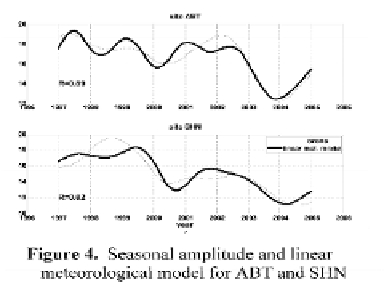Environmental Engineering Reference
In-Depth Information
Weekly amplitude and phase at ABT, shown across the eastern US for two
different times in 2001
(Fig. 5)
illustrate widely varying temporal and spatial
properties of weekday/weekend ozone fluctuation.
Observed and CMAQ diurnal amplitude and phase are compared i
n Figs. 6
and
7. Observed diurnal amplitude at ABT is greater than that of CMAQ. During the
18 years that were modeled, the average diurnal phase difference between
observations and CMAQ is zero (cross-correlations between observations and
model peak at zero lag). However, there are times (as in
Fig. 7)
when the two are
out of phase.
As with seasonal processes, correlations between observed and CMAQ diurnal
variation (0.91 and 0.76 at ABT147 and SHN418, respectively), mostly reflect
phase differences (
Fig. 6
), while observed/model amplitude correlation (0.79 and
0.41) measure the extent to which the model correctly gauges changes in diurnal
forcings (
Fig. 7).
Observation/model agreement was poor at intraday time scales
(<11 h, R 0.26 and 0.19 at ABT and SHN, respectively), reflecting, in part, the
model's inability to simulate stochastic variation like measurement instrument
noise.


